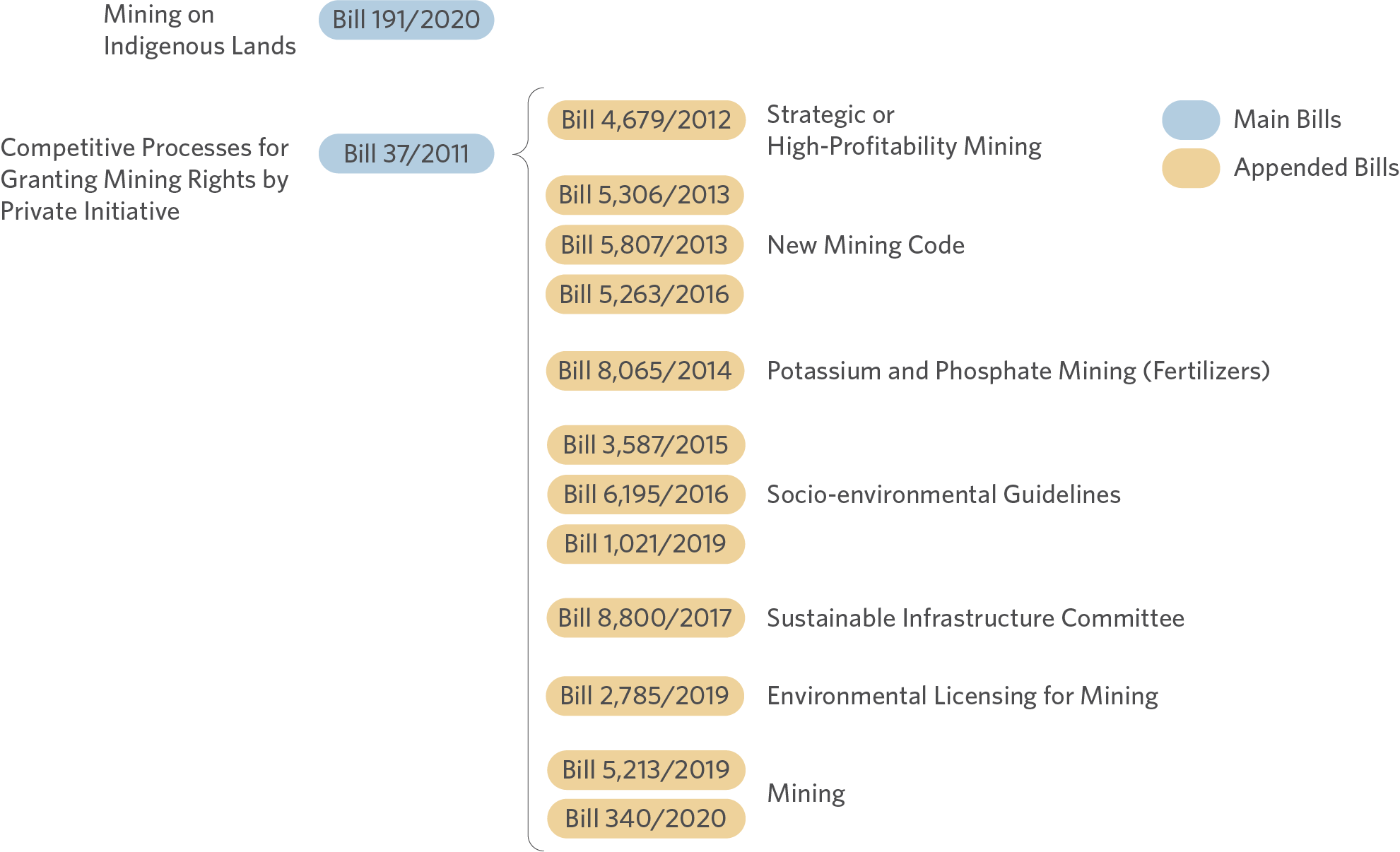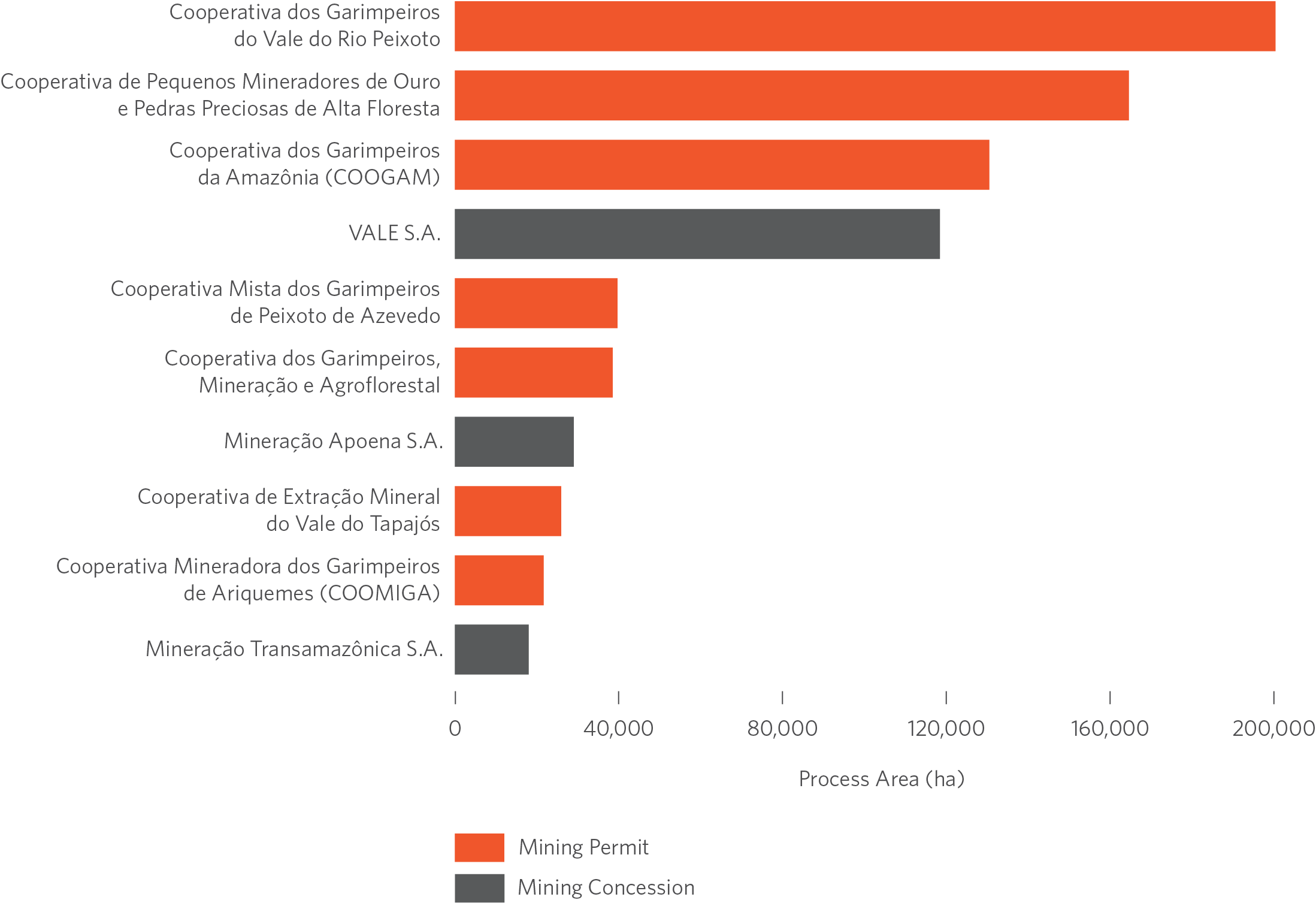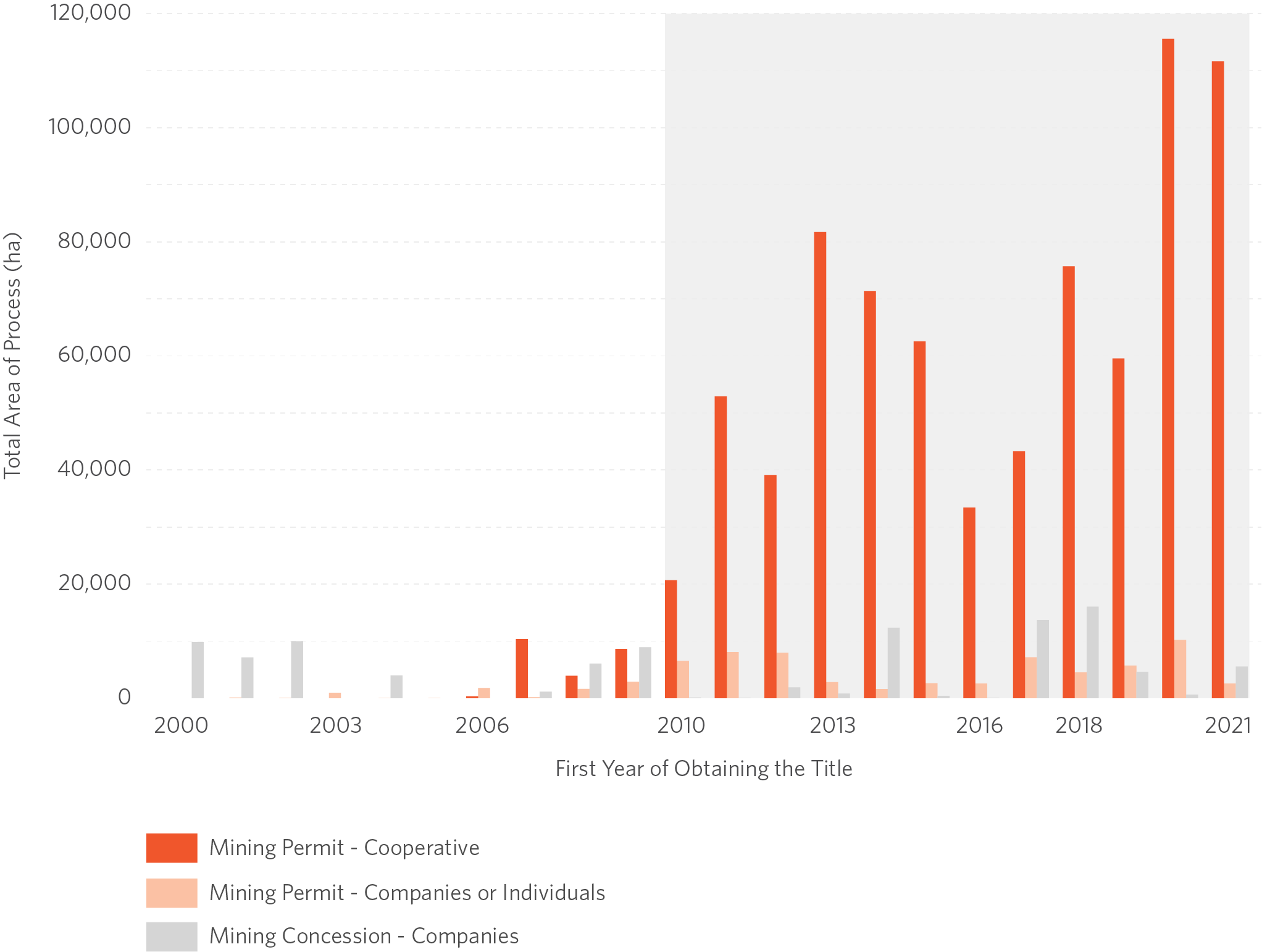INTRODUCTION
Mining is one of Brazil’s oldest economic activities and still plays a vital role in the Brazilian economy. And its importance has increased in recent years.[1] However, the exploration of natural resources requires strict rules due to its enormous socio-environmental impact. This is especially critical in the Amazon, where over 70% of the country’s mining sites were concentrated in 2020, according to data from MAPBIOMAS,[2] leading to deforestation, violence, and conflict with traditional peoples as well as other problems such as slave labor and tax and currency evasion.[3],[4],[5],[6],[7] The serious nature of these impacts is amplified by the high rate of illegality in the sector.[8],[9]
The situation is exacerbated by the fact that mining regulations are complex and outdated. The contradiction is especially clear in the case of informal mining, which the law still treats as an activity carried out by vulnerable individuals with few resources — known as garimpeiros — who therefore deserve legal protection. As a result, cooperatives of garimpeiros, which already operate as businesses in much the same way as the industrial mining companies, have access to a simpler, less-demanding bureaucratic process.[10] These cooperatives are involved in highly capitalized activities using technology and machinery similar to what the industrial operations use, and sometimes working in much larger areas. But they take advantage of the legal benefits available to garimpeiros, which makes it more difficult to prevent and monitor socio-environmental impacts.[11]
Two decrees issued by President Bolsonaro in February of 2022 reinforce the current regulatory contradiction and highlight the government’s inability to handle the socioenvironmental issues as they increase the benefits granted to garimpeiro operations. Decree no. 10,965/2022 directs the Brazilian National Mining Agency (Agência Nacional de Mineração – ANM) to establish simplified licensing procedures for small business ventures, while Decree no. 10,966/2022 creates the Support Program for the Development of Artisanal and Small-Scale Mining (Programa de Apoio ao Desenvolvimento da Mineração Artesanal e em Pequena Escala – Pró-Mape) and the Interagency Commission for the Development of Artisanal and Small-Scale Mining (Comissão Interministerial para o Desenvolvimento da Mineração Artesanal e em Pequena Escala – COMAPE).
The second decree makes no distinction between garimpeiro mining and artisanal and small-scale mining and puts no restrictions on the size or nature of the activity.[12] It also establishes the Legal Amazon as the priority region for COMAPE’s operations. According to the first decree, it should be left to the ANM to decide what qualifies as a small business.[13] but this creates a risk that the agency could be overly lenient.[14]
By allowing garimpeiro cooperatives to operate with even less bureaucracy than the mining industry, and by making them the beneficiaries of incentive policies, these decrees increase the regulatory contradiction between cooperatives and industry, at the expense of the environment.
In this study, researchers from Climate Policy Initiative/Pontifical Catholic University of Rio de Janeiro (CPI/PUC-Rio) present evidence that garimpeiro cooperatives have been used as a means to enable industrial or near-industrial-scale mineral exploration under a weaker regulatory framework. Although the size of a mining site does not necessarily determine whether it is considered an industrial operation, the data is compelling: the three largest garimpeiro gold mining cooperatives in the Amazon are each, individually, larger than industry giant Vale in terms of active mining area, and cooperatives operate seven of the ten largest gold-mining sites in the Amazon that hold mining permits or concessions. The prominence of garimpeiro cooperatives is a recent phenomenon that took root in the 2010s and has intensified in recent years.
These findings support the hypothesis that these cooperatives are operating in a similar way to big mining companies, while taking advantage of legal benefits and distancing themselves from the stricter regulations that apply to industrial mining. The findings also point to the need for regulatory changes to refine the concept of garimpeiro mining so that it considers the industrial nature of the activity — beginning with the immediate revocation of Presidential Decrees no. 10,965/2022 and no. 10,966/2022, which accentuate the legislative inconsistencies and make it more difficult to solve the problem.
CURRENT REGULATORY STRUCTURE OF MINERAL EXPLORATION
The Mining Code (Decree-law no. 227/1967) defines two primary ways mineral rights may be granted, which are of particular interest to studies of mining in the Amazon: the garimpeiro mining permit (Permissão de Lavra Garimpeira – PLG),[15] and mining concessions for industrial mining.[16]
The PLG permit may be obtained by individual garimpeiros and by legal entities (garimpeiros operating as sole proprietors or as a cooperative).[17] It allows for the immediate exploitation of mineral deposits, without any preliminary mineral research,[18] although ANM can elect to perform such research on an exceptional basis.[19] Mining concessions, meanwhile, can only be obtained by industrial mining companies following the completion of preliminary research.[20]
Preliminary mineral research involves delineating the mining site and analyzing its economic viability. It may include geologic, geophysical and geochemical sampling, physical and chemical analyses of samples, and mineral processing.[21] These requirements are thus financially burdensome for the miner — and are not, as previously mentioned, required for PLG permits.
However, according to the Federal Prosecution Office, the absence of preliminary mineral research makes it harder to assess the socio-environmental impacts of garimpeiro mining sites and to combat money laundering, since it is difficult to establish which sites should be monitored, and difficult to identify mining methods and intensity as well as the productivity of a given site.[22]
In addition to being characterized by the absence of preliminary mineral research, the legal definition of garimpeiro mininglacks precision, which is also relevant to the issue of the industry’s socio-environmental impacts.
The Mining Code defines garimpeiro mining as an individual and rudimentary mining activity.[23] This definition, which has existed since 1934 when the first Mining Code was established, relies on the historical image of the garimpeiro as a person who extracts precious metals and stones with a pick axe and a pan, or, at the very most, with manual equipment and portable machines.[24] This definition also aims to protect the garimpeiro as a vulnerable, low-income worker.[25] Meanwhile, Law 7805/1989 and the Garimpeiro Statute (Law no. 11,685/2008) define garimpeiro mining tautologically and without any reference to a rudimentary nature, as an activity involving the exploitation of “garimp-able” minerals, executed within garimpeiro mining sites, under the permitting framework of the PLG.[26],[27]
According to the Federal Prosecutor’s Office, these differing definitions could produce a kind of conceptual indeterminacy that could lead to the practice of industrial mining disguised as artisanal mining. This is particularly serious because the cooperatives that already operate in the Amazon could conceivably be subject to a legal framework that is better suited to the nature of their activities. Indeed, cooperatives that already hold PLG permits are given priority to begin the preliminary research that would allow them to then obtain mining concessions.[28],[29],[30]
Another aspect of the regulation that demonstrates how cooperatives and industrial mining companies are treated similarly is the fact that the maximum land area granted to garimpeiro cooperatives for metallic minerals under the PLG framework is identical to the maximum area for a mining concession: 10,000 hectares.[31]
The regulation thus allows garimpeiro mining to be carried out not only by individual, vulnerable, low-income miners with rudimentary tools, but also by cooperatives of garimpeiros on mining sites just as large as those held by industrial mining companies, using sophisticated equipment and machinery, and with a potential environmental impact similar to that of those companies — but under the weaker regulatory framework that applies to individual garimpeiros, including, in particular, the absence of any obligation to conduct preliminary research in order to obtain a mining permit.
The new presidential decrees aggravate the situation because they further reduce the incentive for cooperatives to adopt the mining concessions framework. Under the new decrees, when these cooperatives operate under PLG permits, they not only continue to have no obligation to conduct preliminary research, but they also gain access to incentive policies and even less bureaucratic processes. These decrees must therefore be revoked immediately and the regulations affecting cooperatives must be reviewed to reverse the disincentives and subject the cooperatives to a legal framework more in line with the nature of their operations.
There is substantial opportunity for regulatory change. Two mining bills are currently being considered in the National Congress: Bill 37/2011, which addresses competitive processes for granting mining rights by private initiative, and Bill 191/2020, which addresses mining on indigenous lands (Figure 1). Bill 37/2011, in particular, contains at least a dozen annexes addressing key topics that could help solve the current regulatory contradiction, including the regulation of garimpeiro mining, a new mining code, environmental permitting, and socio-environmental guidelines.
Figure 1. Legislative Bills Relevant to this Study

Source: CPI/PUC-Rio, 2022
LAND AREA HELD BY GARIMPEIROS IS SIMILAR TO THAT OF MAJOR MINING COMPANIES
This study focuses on gold mining, analyzing the similarities between cooperatives and mining companies. Firstly, this is because more than 80% of active PLG permits in the Amazon are for gold mining, indicating the garimpeiros’ strong preference for gold. Secondly, the practice of garimpeiro gold mining has expanded at a dizzying pace in recent years and has thus come to dominate much of the debate on mining in the region.
In terms of land area granted, cooperatives do not appear any smaller than big mining companies. On the contrary: Figure 2 shows that cooperatives hold seven of the ten largest gold mining sites that have been granted PLG permits or mining concessions. Moreover, it should be noted that three of these cooperatives each hold, individually, greater gold mining areas than Vale, a global leader in the mining sector.
Figure 2. Land Area of the Ten Largest Applicants for and Title Holders of PLG Permits and Mining Concessions

Note: This figure considers only gold mining, and only active sites with PLG permits granted by ANM.
Source: CPI/PUC-Rio with data from the ANM Mining Registry System, 2022
And this pattern is not limited to the biggest gold operations in the Amazon. Figure 3 shows the average land area that each cooperative, company, or individual holds in the Amazon with either a PLG permit or a mining concession. On average, cooperatives with PLG permits hold more than twice as much land as mining companies with mining concessions. This suggests that, in principle, the impact of cooperatives in the Amazon could be significantly greater than the impact of big mining companies.
Figure 3. Average Mining Site Area for Cooperatives and Mining Companies, by Type of Mining Site

Note: This figure considers only gold mining; it looks at the total land area of the mining sites in which a single company operates, and considers only active sites with permits granted by ANM. For the “Others” category, the mining concessions bar includes mostly mining companies, while the PLG permits bar includes companies and individuals.
Source: CPI/PUC-Rio with data from the ANM Mining Registry System, 2022
Furthermore, there are indications of greater oligarchization of the lands granted to cooperatives than there has been with industrial mining companies. In other words, the cooperatives appear to hold a greater concentration of land. Currently, 51 mining companies hold around 334,800 hectares of land under mining concessions, while 57 garimpeiro cooperatives hold over 790,800 hectares under PLG permits.[32]
Such a concentration of land, along with the individual size of each cooperative, supports the hypothesis that the garimpeiros prospecting for gold in the Amazon today are not as vulnerable as the current legislation and the 2022 decrees would make them out to be. It also supports the perception of a contradiction between the regulatory structure and the reality of what garimpeiros actually do. This must be fixed.
And the issue has become increasingly urgent, given the accelerated growth in land area awarded to garimpeiro cooperatives under the PLG permitting regime in the past decade, as shown in Figure 4. Although international gold prices did increase significantly during the same period, this does not seem to be the only explanation for the cooperatives’ expansion, since mining concessions for gold mining did not grow at the same vigorous rate.
Figure 4. Annual Change in Land Area of New Mining Concessions and PLG Permits

Note: This figure considers only gold mining, and only active sites with mining concessions or PLG permits granted by ANM.
Fonte: CPI/PUC-Rio with data from the ANM Mining Registry System, 2022
CONCLUSION
Presidential decrees no. 10,965/2022 and no. 10,966/2022 must be revoked and the regulation of garimpeiro cooperatives must be reviewed. The decrees reinforce the existing contradiction in mining regulations since they create further incentives for cooperatives to pursue mining operations on an industrial scale without adhering to a legal framework that would be more suitable to the nature of their operations.
The regulation that preceded the decrees had already removed the requirement for cooperatives to conduct preliminary mineral research and thus discouraged them from adopting the new mining concessions framework. The decrees give cooperatives access to incentive policies and even less bureaucratic procedures. This further discourages them from adopting the legal framework that would make it easier to prevent and monitor the socio-environmental impacts of mining and to combat the laundering of financial assets earned through garimpeiro mining.
[1] ABM. Revenue in the mining sector grew 36% in 2020. 2021. bit.ly/3IWMxmV.
[2] According to MAPBIOMAS data, 72.4% of Brazil’s total mining area was located in the Amazon in 2020. And that number has increased in recent years: in 2010, 62.7% of the mining area was located in the Amazon.
[3]Idrobo, Nicolás, Daniel Mejía, and Ana María Tribin. “Illegal Gold Mining and Violence in Colombia”. Peace Economics, Peace Science and Public Policy (2013). bit.ly/3pXnMPU.
[4] Pereira, Leila and Rafael Pucci. A Tale of Gold and Blood: The Unintended Consequences of Market Regulation on Local Violence. Rio de Janeiro: Climate Policy Initiative, 2021. bit.ly/3CAqJeh.
[5] Castilhos, Zuleica et al. “Human exposure and risk assessment associated with mercury contamination in artisanal gold mining areas in the Brazilian Amazon”. Environmental Science and Pollution Research 22 (2015): 11255–11264. bit.ly/35LOynu.
[6] Bastos, Wanderley Rodrigues et al. “Mercury in the environment and riverside population in the Madeira River Basin, Amazon, Brazil”. Science of The Total Environment 368, no. 1 (2006): 344-351. bit.ly/3I1zLSV.
[7] Bell, Lee and Dave Evers. Mercury exposure of women in four Latin American gold mining countries: elevated mercury levels found among women where mercury is used in gold mining and contaminates the food chain. IPEN, 2021. bit.ly/3I5jRqu.
[8] Instituto Escolhas. Raio X do ouro: mais de 200 toneladas podem ser ilegais. 2022. bit.ly/3vYPLCU.
[9] Ramos, Raphaela. In July, 73% of deforestation caused by mining in the Amazon occurred on Conservation Units and indigenous land. O Globo, August 24, 2020. glo.bo/3hVKTWK.
[10] MPF. Mineração ilegal de ouro na Amazônia: marcos jurídicos e questões controversas. 2020. bit.ly/3pWmQLD.
[11] Ibid.
[12] Secretaria-Geral. Presidential Decree no. 10,966. Art 4. 2022.
[13] Atos do Poder Executivo. Presidential Decree no. 10,965. Art. 1. 2022.
[14] Secretaria-Geral. Presidential Decree no. 10,966. Art 10. 2022.
[15] Casa Civil. Decree-law no. 227. Art. 2, IV and Art. 73. 1967.
[16] Casa Civil. Decree-law no. 227. Art. 36. 1967.
[17] ANM. Ordinance no. 155. Art. 201. 2016.
[18] Casa Civil. Law no. 7,805. Art. 1. 1989.
[19] Casa Civil. Law no. 7,805. Art. 6. 1989.
[20] Casa Civil. Decree-law no. 227. Art. 11, ‘a’, Art. 14, Art. 18, II, Art. 30, I, and Art. 31. 1967.
[21] Casa Civil. Decree-law no. 227. Art. 14. 1967.
[22] MPF. Mineração ilegal de ouro na Amazônia: marcos jurídicos e questões controversas. 22. 2020. bit.ly/3pWmQLD.
[23] Casa Civil. Decree-law no. 227. Art. 70, I, Art. 71 and Art. 72. 1967.
[24] MPF. Mineração ilegal de ouro na Amazônia: marcos jurídicos e questões controversas. 13-16. 2020. bit.ly/3pWmQLD.
[25] MPF. Mineração ilegal de ouro na Amazônia: marcos jurídicos e questões controversas. 6 and 63-64. 2020. bit.ly/3pWmQLD.
[26] Casa Civil. Law no. 7,805. Art. 10. 1989.
[27] Casa Civil. Law no. 11,685. Art. 2. 2008.
[28] Casa Civil. Law no. 7,805. Art. 14. 1989.
[29] Constitution of the Federative Republic of Brazil. Art. 174, § 4. 1988.
[30] MPF. Mineração ilegal de ouro na Amazônia: marcos jurídicos e questões controversas. 26-36. 2020. bit.ly/3pWmQLD.
[31] ANM. Ordinance no. 155. Art. 42, § 1, and Art. 44, II. 2016. By way of comparison, the maximum land area of a PLG for metallic minerals in the Amazon for individuals is 50 hectares (ANM. Ordinance no. 155. Art. 44, I. 2016.).
[32] There are also 336 individual garimpeiros who operate under PLG permits and hold approximately 74 thousand hectares.

